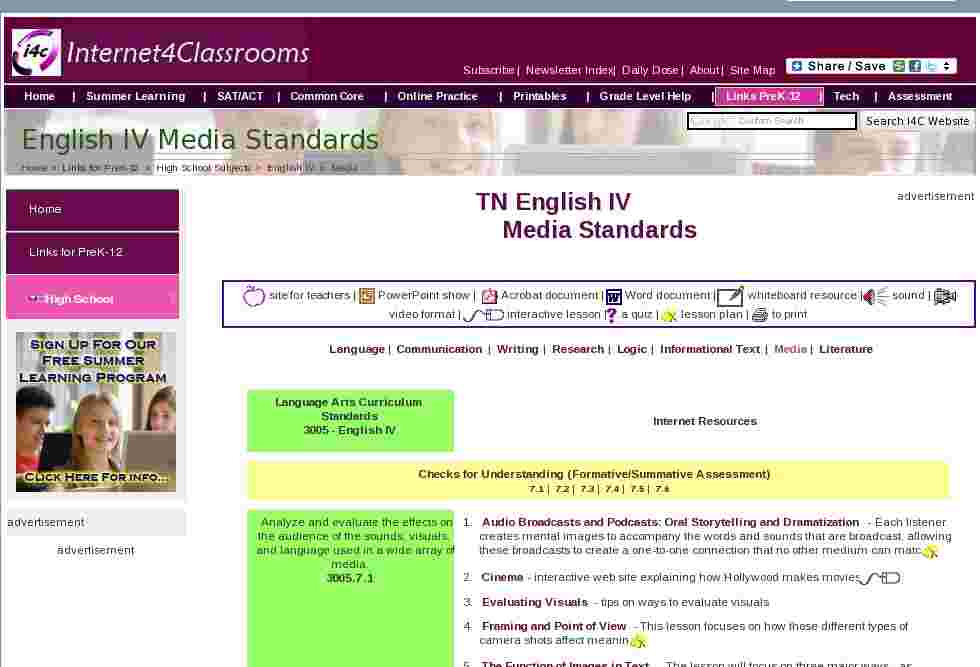TN English IV
Media Standards
site for teachers |
PowerPoint show |
Acrobat document |
Word document |
whiteboard resource |
sound |
video format |
interactive lesson |
a quiz |
lesson plan |
to print
Language | Communication | Writing | Research | Logic | Informational Text | Media | Literature
Language Arts Curriculum Standards
3005 - English IV
- Audio Broadcasts and Podcasts: Oral Storytelling and Dramatization - Each listener creates mental images to accompany the words and sounds that are broadcast, allowing these broadcasts to create a one-to-one connection that no other medium can match.

- Cinema - interactive web site explaining how Hollywood makes movies
- Evaluating Visuals - tips on ways to evaluate visuals
- Framing and Point of View - This lesson focuses on how those different types of camera shots affect meaning
- The Function of Images in Text - The lesson will focus on three major ways - as example, as evidence, and as expression - that images can be used in a text.
- Information Literacy Exercise - example of a web page that should allow students to use both their critical thinking and critical viewing skills.
- Media Awareness - introduces grades 5-8 to the concept of images presented through the media, primarily advertising through print and on television. The unit is divided into three approximately 45-minute lessons.
- Reading a Photograph - activity to help students examine information about photos
- Scanning for Visual Details - This lesson will focus on locating visual details and examining them within the overall context of an image
- Strategies of Thinking Visually: Being First, Doing Second - five strategies of thinking visually
- TV news stories - how to analyze TV news stories and how a story is selected and written [This expired page is from the Internet Archive known as the Wayback Machine.]
- Images: Focus on the details! - Learn how to unlock the meaning of images providing students with a broader understanding of events, objects and people [This expired page is from the Internet Archive known as the Wayback Machine.]
- Photo Analysis Guide - how to analyze photo elements
3005.7.3
- All about Special Effects - interviews with directors and the making of King Kong effects
- Critical Media Literacy: Commercial Advertising - Studying the influence of mass media on our lives
- Get Media Smart - encourages users to think critically about media and become smart consumers. Activities on the site are designed to provide users with some of the skills and knowledge needed to question, analyze, interpret and evaluate media messages
- The Internet's Impact on Political Participation - lesson plan - Discuss what aspects of the Internet and its culture affect individual participation in the political process at the local, state, and national level
- Special effects with a camera - video clips
- TV Smarts for Kids - How media producers use music, lighting, and special effects to achieve specific audience reactions
- Understanding Persuasion - article with key points on how to sway and influence people
- View Smart to Vote Smart - understand how political candidates use the media to deliver their messages-and how television shapes those messages as it delivers them
- Audience Analysis - audience analysis can help you gain valuable insight about your readers
Helpful Hints for Presenters - [16 slides] many good suggestions can be found in this PowerPoint show by Silvi Marina
- In Search of an Audience - consider what attitudes and assumptions potential audience members will bring with them
- Writing Guide: Audience - Recognize that different readers can best understand different messages
- Audience Analysis - audience analysis can help you gain valuable insight about your readers
Helpful Hints for Presenters - [16 slides] many good suggestions can be found in this PowerPoint show by Silvi Marina
- In Search of an Audience - consider what attitudes and assumptions potential audience members will bring with them
- What, then, are some of the things to look for? - scroll down to middle of article for list of nonverbal clues
- Writing Guide: Audience - Recognize that different readers can best understand different messages
- Cause and Effect Chain - graphic organizer [This expired page is from the Internet Archive known as the Wayback Machine.]
- Concept Maps Explained - Concept maps and story webs are visual ways to structure ideas. (sample included
- Copyright in an Electronic Environment - Fair Use Guidelines for Multimedia
- Creating a Multimedia Presentation - Follow the steps to make your multimedia presentation
- Five main types of organizers - links showing examples of many types
Graphic Organizers - from Enchanted Learning
Graphic Organizers from Education Place

Helpful Hints for Presenters - [16 slides] many good suggestions can be found in this PowerPoint show by Silvi Marina
Index of Graphic Organizers - from Inspiration
- Multimedia Presentation Checklist - adaptable for middle school students; a customized checklist that you can print out
- Photo Analysis Guide - how to analyze photo elements
- Short Story Elements - five question multiple-choice quiz
- Ten Tips for PowerPoint Slide Shows - create and deliver visual aids that complement and reinforce your message.
- Twelve Tips for Creating a Better PowerPoint Slide Show - produced by the Communications & Information Technology department at the University of Nebraska - Lincoln

Search Internet4Classrooms
 Custom Search
Custom Search
- Site Map |
- About Us |
- Teacher Training |
- Make Internet4Classrooms.com your home page. |
- Copyright © 2000-2024 Internet4Classrooms, LLC All rights reserved.
Use of this Web site constitutes acceptance of our Terms of Service and Privacy Policy.
1764988072428855 US 1 desktop not tablet not iPad device-width